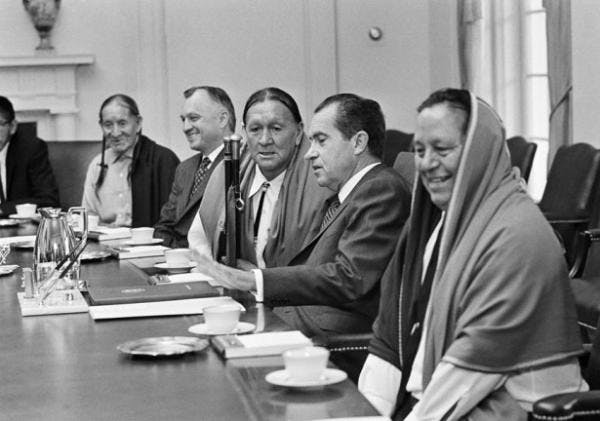
- Details
- By Kaili Berg
On January 4, 1975, President Gerald Ford signed into law the Indian Self-Determination and Education Assistance Act, a piece of legislation that fundamentally reshaped federal-tribal relations.
Fifty years later, this Act is widely regarded as a critical turning point in recognizing tribal sovereignty and empowering Native American tribes to manage their own affairs.
“It was a huge step forward because it recognized tribal sovereignty and allowed tribes to administer federal programs on their own terms,” John Echo Hawk (Pawnee), founder and executive director of the Native American Rights Fund (NARF), said during a recent Native Bidaske commemorating the 50th Anniversary.
The roots of the Act trace back to President Richard Nixon’s policies. In his July 1970 Special Message to Congress on Indian Affairs, Nixon laid the groundwork for federal self-determination policy, rejecting previous efforts to terminate tribes and undermine treaties.
Nixon’s upbringing in Southern California and mentorship under a Native coach at Whittier College highly influenced his understanding of Native communities. With advocates like LaDonna Harris, a prominent Comanche leader, lobbying for tribal rights, Nixon’s administration set a new standard for federal-tribal relations.
“He changed the trajectory,” Echo Hawk said. “Shifting from termination to self-determination and recognizing the inherent rights of tribes.”
The Act enabled tribes to take over the management of federal programs that had previously been administered by federal agencies like the Bureau of Indian Affairs (BIA). These programs spanned education, health care, housing, and social services, allowing tribes to shape policies and services to meet their needs.
Education reform was a key component of the legislation. The Act built on findings from the Kennedy Report on Indian Education, published in 1969, which exposed the systemic failures of federal and mission-run schools.
The report detailed high dropout rates, cultural insensitivity, and mistreatment of Native students, particularly in boarding schools. By empowering tribes to operate their own schools, the Act facilitated a shift toward culturally relevant education.
Echo Hawk explained that the Act allowed tribes to “develop their institutions and administer programs in ways that best serve their citizens.” Over the decades, tribal governments have grown stronger, using this autonomy to address community challenges and preserve cultural traditions.
However, Echo Hawk noted that challenges remain. “Funding inconsistencies and bureaucratic hurdles have always been obstacles, but tribes have shown remarkable resilience.”
It is important to note that this legislation was not merely handed to tribes but was the result of decades of advocacy by tribal leaders and communities. The Menominee Nation’s 1973 Restoration Act and the Northwest fishing rights litigation are prime examples of the momentum leading to the Act’s passage.
As Native communities reflect on the 50th Anniversary, the Act is seen not just as an achievement but as a call to continue the work of self-determination. Younger generations are encouraged to honor this legacy by advocating for their rights and building on the foundation laid by those who came before them.
“This Act wasn’t just about administering programs; it was about recognizing the inherent sovereignty of tribal nations. That fight continues today,” said Echo Hawk.
As tribes continue to navigate challenges and opportunities, the principles of self-governance and sovereignty remain central to their path forward. Fifty years later, the Act is a source of progress and a reminder of what is possible when tribes are empowered to lead their own destinies.
More Stories Like This
Prairie Band Potawatomi Nation Fires Executives After ICE-Related Contract Sparks OutcryTlingit Haida Tribal Business Corporation Clarifies Federal Contracting Work
Homeland Tour Offers Deeper Understanding, Appreciation of Chickasaw Roots
Klamath Tribes Seek to Reverse Judge’s Removal in Water Rights Case
Help us defend tribal sovereignty.
At Native News Online, our mission is rooted in telling the stories that strengthen sovereignty and uplift Indigenous voices — not just at year’s end, but every single day.
Because of your generosity last year, we were able to keep our reporters on the ground in tribal communities, at national gatherings and in the halls of Congress — covering the issues that matter most to Indian Country: sovereignty, culture, education, health and economic opportunity.
That support sustained us through a tough year in 2025. Now, as we look to the year ahead, we need your help right now to ensure warrior journalism remains strong — reporting that defends tribal sovereignty, amplifies Native truth, and holds power accountable.
 The stakes couldn't be higher. Your support keeps Native voices heard, Native stories told and Native sovereignty defended.
The stakes couldn't be higher. Your support keeps Native voices heard, Native stories told and Native sovereignty defended.
Stand with Warrior Journalism today.
Levi Rickert (Potawatomi), Editor & Publisher


